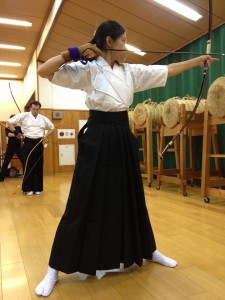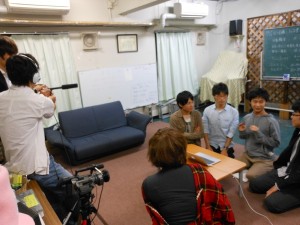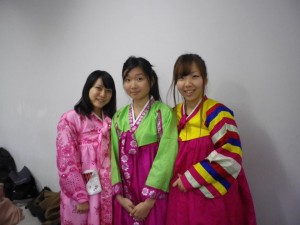Hello!
In the past month, I have been meeting many more Japanese people through church! One of the people I talk to often at church helped me to contact the leader of a Bible study circle at Doshisha, so I have been able to go to two of their meetings so far. At the meetings, which are on Friday afternoons, we read a passage from the Bible and answer questions from a worksheet. I bring my own Bible in English, but I still have trouble understanding the conversations because the vocabulary is difficult and they get deep, but I’ve learned that I don’t have to understand everything to enjoy myself! The most important thing for me is this chance to meet many different people in Japan. One of the girls who attends this circle regularly is not Christian, but she is interested in reading the Bible and learning about Jesus. Even though I don’t always understand and don’t often contribute to the conversation, they have been very accepting of me. By going to these meetings, I have learned a lot of different vocabulary and have been able to work on my listening comprehension, which has really taught me to make the most of any difficult situation!
For the last two church services that I went to, a lot of things happened! We had communion! Because it was very much like any other communion, I felt at home, and as though I have been going to this church for a significant amount of time, instead of just visiting. I got to eat lunch with everyone afterwards, too! The following week, I got to watch two girls get baptized. After a group of the younger people sang songs to congratulate them, the two girls gave their testimonies. Although, again, I couldn’t always understand what they were saying, I could still feel their emotions as they told us about their spiritual journeys. I’m very happy that I had the chance to witness these girls take such an important step in their lives.
I’ve found that, at least at church and at the Bible study circle, Japanese people are not very different from Americans in their customs. Just like the people I met at churches that I have attended in the United States, people here have been very inviting and patient with me. Recently, I have had to go to church by myself, but I’ve learned that if I have even just a little bit of confidence in myself, I can have a lot of amazing experiences! It is also thanks to the many people that I have met for very warmly welcoming me into the church community. Despite my KCJS A-class status, I can still connect with many people! Matthew 17:18 “I tell you the truth, if you have faith as small as a mustard seed, you can say to this mountain, ‘Move from here to there’ and it will move. Nothing will be impossible for you.”
At Kamigyou Intermediate School, I have continued to help students with their English competitions. There were two competitions, one which was for recording the story on a tape to be submitted, and the other for which the students had to perform their speech with arm motions. Within one week, I saw that the students had improved in their intonation, pronunciation, and energy in their movements. I remember that the school’s Vice Principle asked a student to do her best in one of the competitions, which made me realize that these students are pressured to represent their school as best they can. Their determination to do their best for themselves and for their school is inspiring, and makes me want to ganbaru at Japanese, too!
Twice, I have had to casually converse with a couple of girls who were very shy about speaking. Although the students are not shy about reading aloud their passages, they are not comfortable with normally speaking English. Unlike my language teachers who speak to me in their foreign language, the English teacher here usually only speaks Japanese to her students. I’m not sure if the emphasis on reading rather than speaking is a good thing because one of the people I met at church said that even though he studied English since he was little, he cannot say anything in English. Well, in the end, I let the students speak mostly in Japanese to me, but I’ve realized that sometimes, it is more important for them to enjoy English rather than feel stressed out about it.
With only a few more weeks here, I want to make the rest of my limited time here as meaningful as possible by meeting more people and deepening my relationships with the people I have met!



